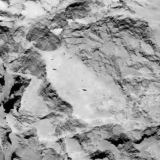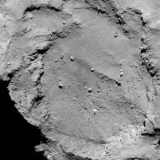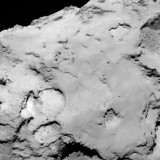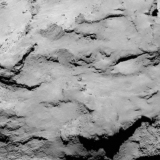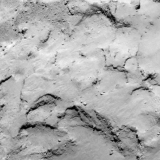Rosetta: Landing site search narrows
25 August 2014
Using detailed information collected by ESA's Rosetta spacecraft during its first two weeks at Comet 67P/Churyumov-Gerasimenko, five locations have been identified as candidate sites to set down the Philae lander in November – the first time a landing on a comet has ever been attempted.
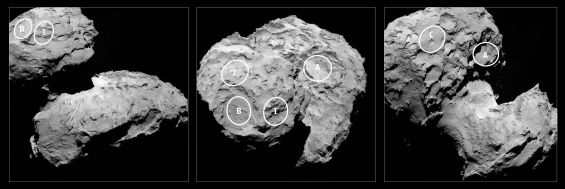 |
| Philae candidate landing sites. Credits: ESA/Rosetta/MPS for OSIRIS Team MPS/UPD/LAM/IAA/SSO/INTA/UPM/DASP/IDA |
Before arrival, Comet 67P/Churyumov-Gerasimenko had never been seen close up and so the race to find a suitable landing site for the 100 kg lander could only begin when Rosetta rendezvoused with the comet on 6 August.
The landing is expected to take place in mid-November when the comet is about 450 million km from the Sun, before activity on the comet reaches levels that might jeopardise the safe and accurate deployment of Philae to the comet's surface, and before surface material is modified by this activity.
The comet is on a 6.5-year orbit around the Sun and today is 522 million km from it. At their closest approach on 13 August 2015, just under a year from now, the comet and Rosetta will be 185 million km from the Sun, meaning an eightfold increase in the light received from the Sun.
While Rosetta and its scientific instruments will watch how the comet evolves as heating by the Sun increases, observing how its coma develops and how the surface changes over time, the lander Philae and its instruments will be tasked with making complementary in situ measurements at the comet's surface. The lander and orbiter will also work together using the CONSERT experiment to send and detect radio waves through the comet's interior, in order to characterise its internal structure.
Choosing the right landing site is a complex process. That site must balance the technical needs of the orbiter and lander during all phases of the separation, descent, and landing, and during operations on the surface with the scientific requirements of the 10 instruments on board Philae.
A key issue is that uncertainties in the navigation of the orbiter close to the comet mean that it is only possible to specify any given landing zone in terms of an ellipse – covering up to one square kilometre – within which Philae might land.
 |
| Philae on the comet. Credit: ESA/ATG medialab |
For each possible zone, important questions must be asked: Will the lander be able to maintain regular communications with Rosetta? How common are surface hazards such as large boulders, deep crevasses or steep slopes? Is there sufficient illumination for scientific operations and enough sunlight to recharge the lander's batteries beyond its initial 64-hour lifetime, while not so much as to cause overheating?
To answer these questions, data acquired by Rosetta from about 100 km distance have been used, including high-resolution images of the surface, measurements of the comet's surface temperature, and the pressure and density of gas around the nucleus. In addition, measurements of the comet's orientation with respect to the Sun, its rotation, mass and surface gravity have been determined. All of these factors influence the technical feasibility of landing at any specific location on the comet.
This weekend, the Landing Site Selection Group (comprising engineers and scientists from Philae's Science, Operations and Navigation Centre at CNES, the Lander Control Centre at DLR, scientists representing the Philae Lander instruments and ESA's Rosetta team) met at CNES, Toulouse, to consider the available data and determine a shortlist of five candidate sites.
"This is the first time landing sites on a comet have been considered," says Stephan Ulamec, Lander Manager at DLR.
"Based on the particular shape and the global topography of Comet 67P/ Churyumov-Gerasimenko, it is probably no surprise that many locations had to be ruled out. The candidate sites that we want to follow up for further analysis are thought to be technically feasible on the basis of a preliminary analysis of flight dynamics and other key issues – for example they all provide at least six hours of daylight per comet rotation and offer some flat terrain. Of course, every site has the potential for unique scientific discoveries."
"The comet is very different to anything we've seen before, and exhibits spectacular features still to be understood," says Jean-Pierre Bibring, a lead lander scientist and principal investigator of the CIVA instrument.
"The five chosen sites offer us the best chance to land and study the composition, internal structure and activity of the comet with the ten lander experiments."
The sites were assigned a letter from an original pre-selection of 10 possible sites, which does not signify any ranking. Three sites (B, I and J) are located on the smaller of the two lobes of the comet and two sites (A and C) are located on the larger lobe.
Summary of the five candidate sites
The next step is a comprehensive analysis of each of the candidate sites, to determine possible orbital and operational strategies that could be used for Rosetta to deliver the lander to any of them. At the same time, Rosetta will move to within 50 km of the comet, allowing a more detailed study of the proposed landing sites.
By 14 September, the five candidate sites will have been assessed and ranked, leading to the selection of a primary landing site, for which a fully detailed strategy for the landing operations will be developed, along with a backup.
During this phase, Rosetta will move to within 20–30 km of the comet, allowing even more detailed maps of the boulder distributions at the primary and backup landing sites to be made. This information could be important in deciding whether to switch from primary to backup.
The Rosetta mission team are working towards a nominal landing date of 11 November, but confirmation of the primary landing site and the date will likely only come on 12 October. This will be followed by a formal Go/No Go from ESA, in agreement with the lander team, after a comprehensive readiness review on 14 October.
"The process of selecting a landing site is extremely complex and dynamic; as we get closer to the comet, we will see more and more details, which will influence the final decision on where and when we can land," says Fred Jansen, ESA Rosetta mission manager.
"We had to complete our preliminary analysis on candidate sites very quickly after arriving at the comet, and now we have just a few more weeks to determine the primary site. The clock is ticking and we now have to meet the challenge to pick the best possible landing site."
More about Rosetta
Rosetta is an ESA mission with contributions from its Member States and NASA. Rosetta's Philae lander is provided by a consortium led by DLR, MPS, CNES and ASI. Rosetta will be the first mission in history to rendezvous with a comet, escort it as it orbits the Sun, and deploy a lander.
Comets are time capsules containing primitive material left over from the epoch when the Sun and its planets formed. By studying the gas, dust and structure of the nucleus and organic materials associated with the comet, via both remote and in situ observations, the Rosetta mission should become the key to unlocking the history and evolution of our Solar System, as well as answering questions regarding the origin of Earth's water and perhaps even life.
For further information, please contact
Markus Bauer
ESA Science and Robotic Exploration Communications Officer
Tel: +31 71 565 6799
Mob: +31 61 594 3 954
Email: markus.bauer![]() esa.int
esa.int

